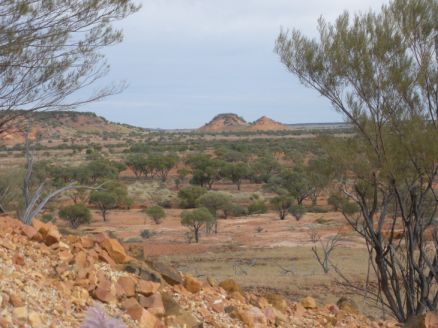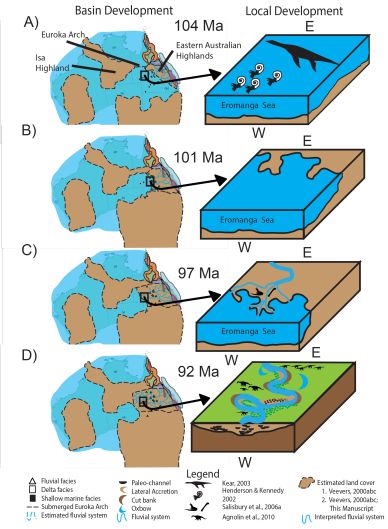Investigating the stratigraphy and palaeoenvironments for a suite of newly discovered mid-Cretaceous vertebrate fossil-localities in the Winton Formation, Queensland, Australia
Title image from: Graphical Abstract by scientific artist Dr. Owen Li: Artistic reconstruction of the uppermost Winton Formation based on sedimentological, trace and body fossil assemblages at Lark Quarry Conservation Park.
The Winton Formation of central Queensland is recognized as a quintessential source of mid-Cretaceous terrestrial faunas and floras by providing a preserved snapshot of Australia's late Mesozoic terrestrial biota. Current diversity of known fossil taxa identified from the Winton Formation includes various dinosaurs, crocodyliforms, aquatic squamates, turtles, lungfish and teleost fishes, along with a floral assemblage that has previously been considered to include some of the world's earliest known flowering plants. However, sedimentological investigations linking fossil assemblages and palaeoenvironments across this unit remain limited (Tucker et al., 2013, 2016).

Landscape shot of the exposed Winton Formation with the area of Lark Quarry Conservation Park viewing west (Near Winton, QLD, Australia).
Dr. Ryan T. Tucker's (now Dept. of Earth Sciences at Stellenbosch University) PhD was to partially investigate and contextualize the depositional environments and improve stratigraphic correlations between multiple fossil localities within the preserved Winton Formation in the Eromanga Basin, including recent fossil discoveries at Isisford, Lark Quarry Conservation Park, and Bladensburg National Park. With the aid of project advisosrs, Dr. Eric Roberts (James Cook University) and Dr. Steve Salusbury (University of Queensland), investigations of regional- and local-scale structural features and outcrop, core and well analysis were combined with detrital zircon provenance signatures to help correlate stratigraphy and vertebrate faunas across the basin. By doing so, Dr. Tucker and co-authors were able to identify that many of these fossil assemblages were entombed within a mosaic of marginal marine to inland alluvial depositional environments. These palaeoenvironments developed synchronously with the final regression of the Eromanga Seaway from central Australia during the late Albian-early Turonian (104-92.5 Ma).
Dr. Tucker and co-authors identified significant palaeoenvironmental differences between the lower and upper portions of the preserved Winton Formation, and therefore informally subdivided the Winton Formation; a lower tidally influenced fluvial-deltaic member and an upper inland alluvial member. This work further demonstrates that the Isisford fauna is part of the lower member of the preserved Winton Formation (see Tucker et al., 2013); whereas, fossil localities around Winton, including Lark Quarry and Bladensburg National Park, are part of the upper member of the Winton Formation. These results permit a more meaningful framework for both regional and global comparisons of the Winton flora and fauna. The full extent and nature of the Winton Formation, its entombed fossil assemblages and dinosaurian track site has yet to be fully addressed, and the overall scientific significance of this formation remains enigmatic. To read more, please see the accepted manuscript within the Journal Sedimentary Geology.

Simplified palaeogeographic maps modified from Veevers, 2000a; Veevers, 2000b ; Veevers, 2000c with symbols showing the retreat of the Eromanga Seaway: A) No older than 104–102 Ma, the first occurrence of coastal deposits in the far east of the basin, as the central and western cores preserve dominantly shallow marine conditions, B) No older than 100–102 Ma, the lower Winton Formation preserve distal deltaic to coastal environments; however far western cores preserve shallow marine sediments, C) No older than 92–94 Ma, the middle Winton Formation deposited preserves fully terrestrial environments except for the farthest western core which preserved coastal-rhythmites, D) The transition into the upper Winton Formation which is estimated to be deposited no older than 92 Ma, in all cores preserves terrestrial associations of sediments and both trace and body fossil assemblages. Temporal rates, palaeocurrent and sediment source terranes discussed in detail within Tucker et al. (2016).
Manuscript Title:
Investigating the stratigraphy and palaeoenvironments for a suite of newly discovered mid-Cretaceous vertebrate fossil-localities in the Winton Formation, Queensland, Australia
Citation:
Tucker, R. T., Roberts, E. M., Darlington, V., & Salisbury, S. W. (2017). Investigating the stratigraphy and palaeoenvironments for a suite of newly discovered mid-Cretaceous vertebrate fossil-localities in the Winton Formation, Queensland, Australia. Sedimentary Geology.
Available online 8 June 2017
In Press, Accepted Manuscript

